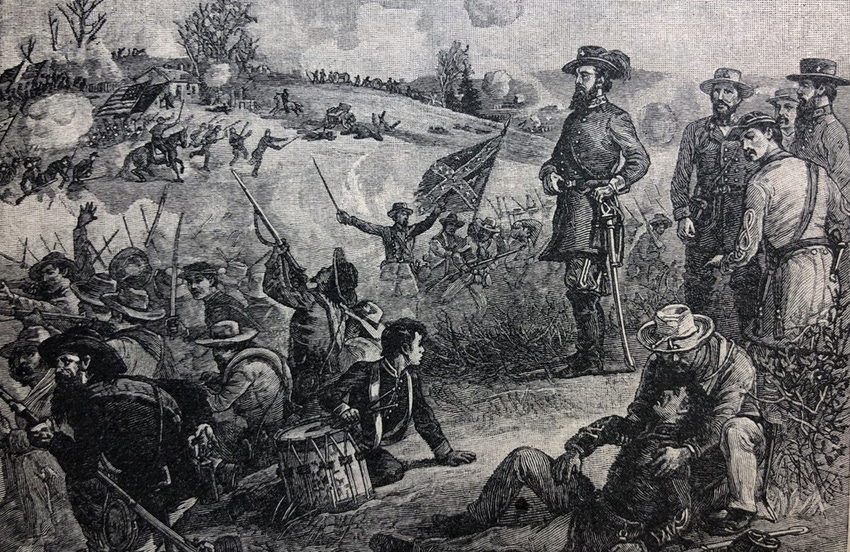
If any of y’all are ever down in our area you just might end up at Albany, Kentucky, about 70 miles north of my headquarters. On the courthouse lawn up there is an historic marker that gives a brief dissertation about Champ Ferguson. The plaque says that he was a notorious murderer.
If you drive 70 miles south to highway 84 and land at French’s cemetery in White County, Tennessee, there is an historic marker in front of Ferguson’s tomb. That marker describes Ferguson as the king of law and order from 1862-1865 in our area. There is an exact opposite viewpoint and printed recording between Albany, Kentucky, and Sparta, Tennessee.
No matter whose side you decide to take, Champ Ferguson was likely the No. 1 guerrilla warrior of the War of Northern Aggression -- also known as the American Civil War.
There have been several books written on Champ Ferguson. At least one takes the Kentucky side. But the best read might be the “Trial of Champ Ferguson,” which I believe is out of print. It is a newspaper account of Ferguson’s trial for war crimes in the summer of 1865 in Nashville. Ferguson was well defended but the circumstances were horrible. In that version he got the shaft and the rope and was one of only two confederates executed for trumped-up war crimes.
The federal prosecutor’s major witness was Tinker Dave Beaty, who testified that he (Beaty) was never inducted into the union army or in uniform and was instructed to kill every Confederate sympathizer at will. He testified to being guilty of essentially the same charges that Ferguson was being accused and on trial for. Ferguson said he never killed a soul that did not plan to kill him. It appears Ferguson’s testimony was accurate.
I say all of this to remind us that we can be right and be found to be wrong by our friends and neighbors and even the government and university officials. Hopefully we won’t get hung, however.
Walt Davis corrected me about a common misconception I held several years ago concerning the near extinction of the North American bison herd following the Civil War. I previously thought that the hide and tongue market lead to the buffalo’s demise and there were millions (maybe 5,000,000) killed over a four- or five-year period in the early to mid-1870’s. But a few years earlier the buffalo herd numbered between 20 to 40 million. What happened to them?
In the late 1860’s, Charles Goodnight, the famous Texas and New Mexico rancher reported in his journals while scouting the Goodnight trail to Colorado that there were miles of dead buffalo. A few years later a herd of South Texas cattle went through Goodnight’s West Texas ranch and led to a huge death loss of his cows with what we think was tick fever. Similar outbreaks had occurred in Kansas when South Texas cattle were wrangled north. Several deep-south states were quarantined from cattle movement north during much of the first half of the 20th century.
Several years later it was determined that a couple of tick-borne rickettsial and protozoal organisms were likely the cause of tick fever (Anaplasma and Babesia). Biting flies in general and horse flies in particular are the most serious and most important vectors, and transfer the organisms from animal to animal. The ticks are important for organism survival, reproduction and growth. The flies and their scissors are really good at spreading the maladies. Cattle raised in tick fever country have good immunity but they have and carry the bugs in several of their red blood cells. Consistent exposure keeps their immune levels quite high.
But the truth is likely that they lose their immunity after removal from ticks and horse flies, especially the ticks. Seasons are shorter as you go north. Diversity of bug populations may decrease.
During the Civil War the South Texas cattle herd grew tremendously. After the war there were several million head of semi-wild healthy longhorn cattle. They were mostly carriers of tick fever (Anaplamosis and Babesiosis). Cattle and likely buffalo to the north and west had near zero immunity. Both died in big numbers in the years following the war. Microscopic organisms killed more buffalo than bullets. The adult animals died at a much higher rate than the calves or yearlings. Likely this was due to less active bone marrow blood formation in mature animals.
The old principle and rule of keeping your cattle close to home and not buying cattle from west or north is worth remembering and practicing. Bringing in new cattle (especially adults) can end in a very expensive learning experience. There is stuff out there that Ajax won’t wash off. You also need to think a lot before you bring in Deep-South cattle.
On the other hand, moving cattle every day to new pastures that are plant diverse and completely recovered should be considered a rule. Yet that hasn’t been the historical precedent.
The opinions of the author are not necessarily those of Beef Producer or Farm Progress.
About the Author(s)
You May Also Like






